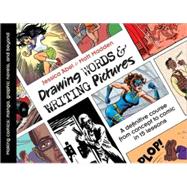
What is included with this book?
Booklist
The passion for comics is surging worldwide, what with the popularity of manga and graphic novels and memoirs. Abel, whose graphic novels include La Perdida (2006) and Life Sucks (2008), and Madden, creator of the unusual 99 Ways to Tell a Story (2005), make learning the art of comics fun and exciting in this exceptionally well designed and friendly how-to. Present on the page as comic figures, Abel and Madden present expertly configured sequences of skill-building exercises and assignments, and encourage both novices whose drawing skills may be minimal but whose story ideas are compelling, and those adept at visual art but shaky on narrative. Numerous examples of comics rendered in a broad spectrum of styles and perspectives, and exploring a wide array of subjects and genres, accompany and reinforce detailed instructions. Lively, sophisticated, and comprehensive, Abel and Madden’s course in visual storytelling covers every narrative and graphic element, from drawing figures and character development to panel transitions, composition, lettering, depicting action, and penciling and inking techniques. Technically precise, zippy, and inspiring, this is an outstanding teaching book. — Donna Seaman
Review in Kirkus
Smartly designed and easy to understand, Abel and Madden’s text is an edifying course in creating comics. Comprised of 15 comprehensive lessons, readers are taught the basic elements necessary to conceptualize and produce their own comics. Assuming an audience range from individuals to a group, this pedagogical survey is written to serve a wide array of learners. The authors suggest everything from preferred brands of supplies to types of stretches to alleviate strain. Extensive backmatter, including helpful appendices on such topics as homework critiques, and a considerable bibliography round out the volume. This erudite study should leave its readers with a greater understanding and appreciation of the command one must possess to create graphic media. A valuable resource for all interested in the field and a natural companion to Scott McCloud’s quintessential texts Understanding Comics and Reinventing Comics. (appendices, index, bibliography) (Nonfiction. YA & adult)
Recommended Review in BCCB
Comics are increasingly appreciated as complex, sophisticated blends of illustration and text, and this volume is a timely, in-depth examination of the format. This exhaustively comprehensive guide to creating comics features fifteen individual lessons that take readers from concept to finished product. A landscape-formatted paperback chock-full of diagrammatic examples, the book looks every bit the sophisticated how-to, and the tone is encouraging, highlighting comic strips that have rudimentary artwork or simple concepts and encouraging readers to explore everything from formal, paneled comics to wildly imaginative freeform interpretations. The authors offer guidelines on how the book can be used by individuals, by groups, and by classes; regardless of whether one goes it solo or uses the volume with a course, the accessible and highly detailed lessons on everything from penciling to structuring a story to selecting a title will engage and inform readers. The first fourteen chapters include background information, activities, sidebars with related but not directly relevant information, a homework assignment, and an extra credit activity, with the final chapter being a challenge to create a full comic in one day. Extensive end matter presents almost as much information as the guide itself: appendices offer hints about necessary supplies, book reports that can be done on comics, and the making of minicomics, and an extensive bibliography suggests both graphic novels or comics that emphasize points in the lessons as well as drawing handbooks. Serious readers seeking information will be drawn by the witty, informal tone and casual narrative voice as much as the impeccably designed and accessible lessons.
Voya: 4Q 2P
Abel and Madden write a concise textbook for people wanting to learn how to create coherent and marketable comics. Lessons focus on panel design and comic layout with detailed illustrations demonstrating each concept. In comics, writing is as important as images and the artist needs to make sure each component is conveying the correct meaning so as not to confuse or bore the reader with irrelevant dialogue. Comics require a storyline not unlike a novel where the protagonist keeps the action moving until a situation or conflict is resolved. How to create that story and design it into a comic format is outlined through fifteen chapters and several appendixes, from the formation of thumbnail sketches and character development to the production of the final comic copy through photocopying or scanning in Adobe Photoshop. For those unfamiliar with Photoshop, simple step-by-step directions are given to assist in creating the final masterpiece.
The text, designed for classroom use by teachers or as an individual tutorial, comes with further reading suggestions, homework assignments, and extra credit projects at the end of each lesson. The assignments are well formulated to reinforce the techniques taught in each section; however, students looking for drawing instruction on creating characters and backgrounds will be sorely disappointed. This book is not designed to teach would-be artists how to draw but how to write and give dimension to drawings through penciling strategies, lettering techniques, and inking with pens or brushes. Students looking to create their own mini comics for publication will welcome the design pointers. – Laura Panter
The New copy of this book will include any supplemental materials advertised. Please check the title of the book to determine if it should include any access cards, study guides, lab manuals, CDs, etc.
The Used, Rental and eBook copies of this book are not guaranteed to include any supplemental materials. Typically, only the book itself is included. This is true even if the title states it includes any access cards, study guides, lab manuals, CDs, etc.